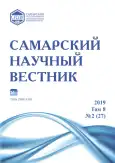Asymmetric conflicts in the British Empire in the writings of W. Churchill
- Authors: Golosova A.A.1
-
Affiliations:
- Samara State University of Social Sciences and Education
- Issue: Vol 8, No 2 (2019)
- Pages: 309-313
- Section: 07.00.00 – Historical Sciences and Archaeology
- URL: https://journals.rcsi.science/2309-4370/article/view/34335
- DOI: https://doi.org/10.17816/snv201982231
- ID: 34335
Cite item
Full Text
Abstract
This paper analyzes the materials of Winston Churchill of the first third of the XX century, dedicated to his participation in asymmetric military conflicts on the periphery of the British colonial empire. First, it allows us to consider the concept of asymmetric conflict in relation to the British army at the turn of the century and after the First World War. Secondly it allows us to analyze methods, forms and ways of waging war in the conditions of unequal power capabilities, which help to get to know the way of the colonial margins, which was formed by the British in the context of ongoing conflicts. The paper traces a clear chronology in accordance with the works of Winston Churchill: the Cuban War of Independence, the uprising of the Pashtun tribes in Malakand, the Mahdist uprising in Sudan, the second Anglo-Boer War, and the Irish War of Independence. Winston Churchill served in the British Army personally, at the same time he served as a war correspondent covering military events from the front line. Only the Irish War of Independence is knocked out of the chain of events. It was an asymmetric military conflict, perceived by W. Churchill from a completely different perspective: through the prism of political experience and from the height of his position of a Minister of Colonies. In the paper we conclude that the colonial era is the basis for the formation of the theoretical component of the asymmetric conflict concept.
Full Text
##article.viewOnOriginalSite##About the authors
Anna Aleksandrovna Golosova
Samara State University of Social Sciences and Education
Author for correspondence.
Email: tzyganova.annet@yandex.ru
master student of World History, Law and Methods of Teaching Department
Russian Federation, SamaraReferences
- Дергилазова Л.В. Асимметричный конфликт в современной американской политологии // Журнал «Международные процессы». 2002. № 2. С. 51-64.
- Дериглазова Л.В. Историография изучения асимметричных конфликтов // Вестник Томского государственного университета. 2008. № 308. С. 66-72.
- Mack A. Why Big Nations Lose Small Wars: The Politics of Asymmetric Conflict // World Politics. 1975. Vol. 27, № 2. P. 175-200.
- Тетерюк А.C., Чижевский Я.А. Асимметричные конфликты в теории международных отношений: современные аспекты изучения // Сравнительная политика. 2015. № 4 (21). С. 24-26.
- Черчилль У. Мои ранние годы. 1874-1904. М.: КоЛибри, 2011. 368 с.
- Ивкина Л.А. Несостоявшийся диалог. Куба и Испания в 30-90-е гг. XIX в. // Латиноамериканский исторический альманах: сборник / под ред. А.А. Щелчкова. М.: Центр латиноамериканских исследований ИВИ РАН, 2010. № 10. С. 138-173.
- Черчилль У.С. Индия, Судан, Южная Африка. Походы Британской армии 1897-1900. М.: Эксмо, 2004. 560 с.
- Holmes R. In the Footsteps of Churchill. The Bubble Reputation 1895-1901. NY: Basic Books, 2005. 398 p.
- Ogden H.J. Daily news, June 1, 1900: Poisoned and Explosive Bullets? Bullets - Expansive and Explosive // The war against the Dutch republics in South Africa: its origin, progress, and results. Manchester: The National reform union, 1901. P. 145.
- Конан Дойл А. Англо-Бурская война (1899-1902). М.: Эксмо, 2004. 688 с.
- Свечин А.А. Эволюция военного искусства. Т. II. М.-Л.: Военгиз, 1928. 613 с.
- Дроговоз И.Г. Англо-бурская война 1899-1902 гг. Мн.: Харвест, 2004. 400 с.
- Воропаева Н.Г., Вяткина Р.Р., Шубин Г.В. Англо-бурская война 1899-1902 гг. По архивным материалам и воспоминаниям очевидцев. М.: Издательская фирма «Восточная литература» РАН, 2001. 530 с.
- Воропаева Н.Г. Англо-бурская война. Вооружённые силы Великобритании // Журнал «Сержант». 2005. № 31. С. 59-65.
- Черчилль У. Мировой кризис. 1918-1925. М.: Либроком, 2017. 334 с.
- Ллойд Джордж Д. Военные мемуары. В 2 т. М.: Соцэкгиз, 1934. 679 с.
- Сили Дж.Р. Британская империя. М.: Алгоритм, 2015. 272 с.
- Bew P. Churchill and Ireland. Oxford: Oxford University Press, 2016. 215 p.
Supplementary files






